Notoedric mange
Notoedric mange, also referred to as Feline scabies, is a highly contagious skin infestation caused by an ectoparasitic and skin burrowing mite Notoedres cati (Acarina, Sarcoptidae). N. cati is primarily a parasite of felids, but it can also infest rodents, lagomorphs, and occasionally also dogs and foxes. This skin disease also has zoonotic potential.[2][3] Infestation is also called acariasis, which refers to a rash that is caused by mites.[4]
| Notoedric mange | |
|---|---|
 | |
| Scientific classification | |
| Domain: | Eukaryota |
| Kingdom: | Animalia |
| Phylum: | Arthropoda |
| Subphylum: | Chelicerata |
| Class: | Arachnida |
| Order: | Sarcoptiformes |
| Family: | Sarcoptidae |
| Genus: | Notoedres |
| Species: | N. cati |
| Binomial name | |
| Notoedres cati (Hering, 1838) | |
| Synonyms[1] | |
| |
Signs and symptoms
Infestation of N. cati causes several symptoms such as severe itchiness, alopecia, scales and characteristic dry, crusted, pruritic lesions that first appear in the region of the ears and rapidly spreads over the face, eyelids, neck and continues to infest the whole body.[5][6] Clinical symptoms appear within the incubation period, which is most commonly 10 days to 8 weeks after transmission has happened from contact with an infested animal.[7] Skin will become thickened and colour of crusting will change yellowish or grey as the parasitic disease progresses.[6][8][7] Self-trauma because of severe itching can cause excoriations to develop severe dermatitis, secondary bacterial infections. Far progressed Notoedric mange often leads to apathy, anorexia and even death.[9] In humans, infestation of N.cati can result in transient pruritic lesions.[10]
Cause
Notoedric mange is caused by the sarcoptic mite Notoedres cati that belongs to the family Sarcoptidae that consists of the burrowing mites. N. cati burrows its way through the skin of the host animal, which results in intense itching. Characteristic symptoms for Notoedric mange result from an allergic reaction of the host's body against the mites' extracellular products and also of the mechanical damage resulting from burrowing through skin.[11][12]
Diagnosis
There are several conditions that veterinarians usually first rule out when diagnosing Notoedric mange. These out ruled conditions can be for example; otoacariasis, atopic dermatitis, pemphigus, food hypersensitivity, autoimmune diseases and systemic lupus erythematosus.[13] Otoacariasis is a rare infestation of the ear canal, which can be caused by different types of mites and ticks.[14]
Most commonly N. cati as a cause of Notoedric mange may be diagnosed from a skin scraping sample with a direct microscopic identification of the mite, because there are a large number of mites present on the skin. Characteristic and systemic symptoms of Notoedric mange also help with diagnosis.[12]
Contagion
This parasitic skin disease is highly contagious and it is primarily transferred by direct contact with an infested animal.[8][5][6] N. cati can survive for 1–3 days outside a host, and during that time the mite can transfer to another animal.[7]
Treatment
Certain antiparasitic drugs used to control Notoedric mange include selamectin, moxidectin, ivermectin and lime sulfur dips.[2][8][12][7] Lime sulfur is most commonly used and safe pesticide to control Notoedric mange on cats. Treated cats should not be allowed to groom before their coat is fully dried after treatment, because lime sulfur can cause toxicity if it is orally ingested.[12] Lime sulfur is also commonly used along the side of Notoedres as a treatment for Sarcoptes, Demodex, Cheyletiella, Lynxacarus, chiggers and lice infections.[15]
See also
References
- Notoedres cati (Hering, 1838) in GBIF Secretariat (2019). GBIF Backbone Taxonomy. Checklist dataset doi:10.15468/39omei accessed via https://www.gbif.org/species/2181903 on 2020-02-24.
- Kumar, K. Senthil; Selvaraj, P.; Vairamuthu, S.; Srinivasan, S. R.; Kathiresan, D. (November 2008). "Ivermectin therapy in the management of notoedric mange in cats".
{{cite journal}}: Cite journal requires|journal=(help) - “Notoedres.” The Merriam-Webster.com Medical Dictionary, Merriam-Webster Inc. Accessed 24 November 2019
- Acariasis, Mange and Other Mite Infestations, www.cfsph.iastate.edu, Last Updated: June 2012
- Kraabøl, Morten; Gundersen, Vegard; Fangel, Kirstin; Olstad, Kjetil (17 December 2015). "The taxonomy, life cycle and pathology of Sarcoptes scabiei and Notoedres cati (Acarina, Sarcoptidae): A review in a Fennoscandian wildlife perspective". Fauna Norvegica. 35: 21–33. doi:10.5324/fn.v35i0.1652.
- Hnilica, Keith A.; Patterson, Adam P. (2017). "Parasitic Skin Disorders". Small Animal Dermatology. pp. 132–172. doi:10.1016/B978-0-323-37651-8.00005-5. ISBN 9780323376518.
- Dryden, Michael W. "Mange in Dogs and Cats - Integumentary System". Veterinary Manual.
- Bowman, Anastasia (June 25, 2014). "Notoedres cati". American Association of Veterinary Parasitologists.
- Hellmann, Klaus; Petry, Gabriele; Capari, Balazs; Cvejic, Dejan; Krämer, Friederike (13 June 2013). "Treatment of Naturally Notoedres cati-infested Cats with a Combination of Imidacloprid 10 % / Moxidectin 1 % Spot-on (Advocate® / Advantage® Multi, Bayer)". Parasitology Research. 112 (S1): 57–66. doi:10.1007/s00436-013-3281-y. PMID 23760872.
- Mullen, Gary R.; Durden, Lance A. (2009). Medical and Veterinary Entomology. Academic Press. ISBN 978-0-08-091969-0.
- Panigrahi, P. N.; Mohanty, B. N.; Gupta, A. R.; Patra, R. C.; Dey, S. (2016). "Concurrent infestation of Notoedres, Sarcoptic and Psoroptic acariosis in rabbit and its management". Journal of Parasitic Diseases. 40 (3): 1091–1093. doi:10.1007/s12639-014-0631-3. PMC 4996244. PMID 27605843.
- Pinchbeck, Lauren R.; Hillier, Andrew (2006). "Scabies, Notoedric Mange, and Cheyletiellosis". Saunders Manual of Small Animal Practice. pp. 465–473. doi:10.1016/B0-72-160422-6/50046-2. ISBN 9780721604220.
- Mauldin, Elizabeth A.; Peters-Kennedy, Jeanine (2016). "Integumentary System". Jubb, Kennedy & Palmer's Pathology of Domestic Animals: Volume 1. pp. 509–736.e1. doi:10.1016/B978-0-7020-5317-7.00006-0. ISBN 9780702053177. S2CID 90764966.
- Cakabay, Taliye; Gokdogan, Ozan; Kocyigit, Murat (September 2016). "Human otoacariasis: Demographic and clinical outcomes in patients with ear-canal ticks and a review of literature". Journal of Otology. 11 (3): 111–117. doi:10.1016/j.joto.2016.06.003. PMC 6002594. PMID 29937819.
- Page, Stephen W. (2008). "Antiparasitic drugs". Small Animal Clinical Pharmacology. Elsevier. pp. 198–260. doi:10.1016/B978-070202858-8.50012-9. ISBN 9780702028588.